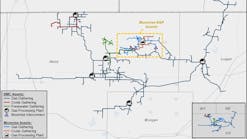Bakken leader Continental Resources drills deeper into Three Forks formation
DUNN COUNTY, ND — The Bakken-Three Forks tight oil formation is already one of the top producing oil plays in the US, but leading operator Continental Resources Inc. believes there may be even more oil in place than previously thought in deeper benches of the Three Forks formation.
The bulk of production in the play now comes from the Middle Bakken and the shallowest layer of the underlying Three Forks formation, the Three Forks 1.
Continental, which pioneered development of the tight oil play, will this year drill more than two dozen exploratory wells into three deepest benches of the Three Forks after seeing encouraging results from 20 exploratory wells drilled there in 2013.
Testing new zones
Rick Bott, president and chief operating officer of Continental, said the company made strides in improving its understanding of the deeper benches of the Three Forks in 2013.
"We proved some big things," Bott said in a February investor presentation. "We've proved there is good quality rock, we've proved that there's oil in there, (and) we've proved that we can produce at commercial rates."
The Bakken-Three Forks play, which stretches across portions of North Dakota and Montana, is stacked with different geologic layers, akin to a multilayer cake. The Upper, Middle, and Lower Bakken are closest to the surface, with the bulk of production coming from the Middle Bakken. Beneath the Lower Bakken are the first, second, third, and fourth benches of the Three Forks formation.
Commercial Three Forks production now comes from the first bench, but Continental in 2013 began pilot projects testing productivity of the lower three benches with encouraging results.
Pilot project
The Hawkinson unit density drilling pilot program in Dunn County, ND, is one example of Continental's efforts to tap into the lower three benches of the Three Forks.
The project used a megapad containing 14 wells targeting multiple, stacked pay zones. Included were four wells targeting the Middle Bakken, three targeting the Three Forks 1, four targeting the Three Forks 2, and three targeting the Three Forks 3.
The unit, which spans 1,280 acres, tested at an initial combined monthly rate of 14,850 boe/d from all 14 wells.
Continental said the Hawkinson unit was the industry's first multi-interval, lower bench development targeting the Three Forks.
Continental has so far delineated roughly 3,800 sq miles of productivity in the lower three benches of the Three Forks. Future efforts will focus on further delineation of the lower Three Forks benches and determining the best development techniques—an effort that includes deciding how many wells to drill, how to position them, and how to hydraulically fracture the intervals most efficiently.
Hawkinson also exemplified Continental's efforts to improve recovery from the Bakken-Three Forks play by testing tighter well spacing and drilling more wells from a single megapad. Continental has four pilot projects in progress that will test even tighter well spacing than was used in Hawkinson.
While wells in the Hawkinson unit were spaced 1,320 ft apart in the same zone and offset 600 ft in adjacent zones, Continental's planned Wahpeton, Lawrence, Mack, and Hartman units will space wells 660 ft apart in the same zone and offset 330 ft in adjacent zones.
"These density pilots essentially increase the recovery factor expectations of the field," Bott told analysts during a call to discuss third quarter earnings.
Thirty-one wells are to be drilled across the four pilot projects. Like Hawkinson, the projects will also target multiple intervals—namely the Middle Bakken and the upper three levels of the Three Forks.
Bigger pads
Continental also plans to this year use more megapads—which can hold up to 30 wells each—in parts of its flagship Antelope area, spanning Mountrail, McKenzie, and Williams counties, ND.
The company is moving forward with full-field development of Antelope, with four rigs slated to drill 50 gross wells there in 2014.
Increasing the number of wells drilled from a single pad enables drilling to occur more quickly, reduces mechanical problems by allowing the company to become familiar with the rock in a given area, and enables midstream vendors to run oil, gas, and water pipelines to a single location. Other advantages include the use of a single road, electrical system, and tank battery complex to hold oil and flowback water.
Optimization efforts like those seen at planned megapads in the Antelope area are generating savings for Continental.
The average cost of a Bakken-Three Forks well declined to $8.0 million from $9.2 million in the past year and a half, and the company expects to further reduce costs to $7.5 million by the end of 2014. Bott said the average industry well cost is $11.3 million.
Growing room
Continental drilled its first Bakken well in 2004 and is now the biggest producer, most active driller, and largest leaseholder in the Bakken-Three Forks play at 1.2 million net acres.
Output from the Bakken-Three Forks tight oil play helped Continental raise its production 35% last year, and the company expects further production growth in the years ahead as it delineates the deeper benches of the Three Forks formation and moves into full-field development across the play.
The Bakken-Three Forks accounted for 93,300 boe/d of Continental's production of 144,300 boe/d at year-end 2013, and company-wide output is expected to more than double to 300,000 boe/d by 2017.
Roughly half of the company's 2014 capital spending budget of $4.05 billion is allocated to the Bakken-Three Forks, with 300 net wells planned for 2014.
The company's continuing efforts to improve its understanding of the Bakken-Three Forks are contributing to a rising reserve base. Proved reserves totaled 1.08 billion boe at year-end 2013, a 38% increase compared with yearend 2012.
Bott told investors about two thirds of reserves growth over the past 5 years has come from Bakken-Three Forks.
Continental's reserves are likely to grow even more even in the years ahead as the company continues its work to delineate the deeper benches of the Three Forks play.

